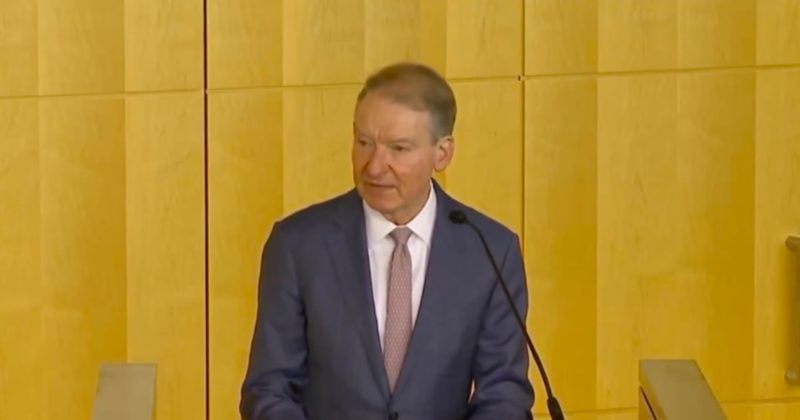Get up to date on the latest analysis and trading tips with our Crypto update week 41
- Why Ethereum is Selling-Off After the Merge?
- Is Huobi Token Megaphone Pattern Bullish or Bearish?
- How to Measure the Strength of a Crypto Trend with the Aroon indicator
Ethereum (ETH) has lost over 26% of its value post-merge upgrade in what appears to be a “buy the news, sell the fact” event. There are a few technical reasons for the current downturn in ETH’s price that we’re going to explore below.
But before we dive deep into the technical reasons, it’s important to remember that the merge will play a more prominent role on the ETH price in the long term, while the technical forces are driving the price in the short term.
ETH Bear Flag
We have a post-merge technical pattern in the form of a bearish flag formation. The initial sell-off right after the merge formed the flagpole. The tight consolidation between the $1,400 resistance level and the $1,221 support level that followed created the flag.
The ETH bearish flag pattern is only confirmed once the bottom of the flag is broken. It’s critical to wait for confirmation in this case to confirm the chart pattern.
The potential measured move target of the bearish flag is near $1,000.
What is a Bear Flag?
The Bear Flag is a bearish continuation pattern that can form after a prolonged downtrend. It looks like a flag with a mast on either side, and it occurs when the price consolidates within a tight range before breaking out to the downside. The Bear Flag typically forms during a period of consolidation after a sharp decline, and it can be used to confirm that the downtrend is still intact. A break below the flag support level can be used to trigger short sell orders.
ETH’s ABC Corrective Pattern
Another clear pattern that emerged on ETH’s daily chart is the formation of a potential ABC pattern. The first leg down ended at the August 28 low, and the pullback in wave B ended a few days before the merge event.
Currently, wave C is in progress as the breakout below the August 28 low opened the door for a possible retest of the $1,000 support level. The ABC correction wave will usually target the area between 1 and 1.272 Fibonacci extension levels of wave A measured against the high of wave B.
We only had one brief daily close below this level on June 18, which was quickly reversed. Moving forward, we can expect this level to be protected by the bulls.
Over the past 3.5 months, Huobi Token (HT) has been developing a megaphone pattern, also known as the broadening pattern. The pattern is neither bullish nor bearish, but it hints at a period of heightened volatility as long as HT’s price remains trapped inside the megaphone support and resistance levels.
HT Megaphone Pattern
The megaphone pattern can be recognized by successive higher highs and lower lows. On the price chart, this pattern is visible by two diverging trendlines. Usually, the pattern marks a period of high volatility with no clear market direction.
HT’s price is testing the upper resistance trendline of the megaphone pattern around the $7.10 level.
RSI Oscillator
After the recent sharp rally, HT’s price is greatly overbought. The Relative Strength Index (RSI) has reached its highest reading of 84 since February 2021. Fears of the rally losing momentum are justified, as other technical factors are calling for a pause.
Aside from being at extreme overbought levels, HT’s price is also battling the key 200-day simple moving average.
200-Day Simple Moving Average
While we broke above the 200-day simple moving average, it remains to be seen how this plays out within the megaphone pattern. For a fundamental shift in the market sentiment, we need multiple daily closes above the 200-day SMA.
The current daily candle already shows signs of rejection at the megaphone resistance trendline, which may be another sign that, in the short term, the bullish momentum is running out of steam.
Looking forward: To the downside, the first support area is the $5.00 big psychological level. A daily break and close below $5.00 will eventually open the door for a retest of the lower support trendline.
In trading, there are only two decisions every trade must make. You can either be a trend follower or take a contrarian approach by trading against the trend. To succeed with both trading styles, you only need to know if the trend will continue or reverse. This is why everyone needs to learn how to measure the trend’s strength.
What is the Aroon indicator?
The Aroon Indicator is a technical analysis tool that was developed by Tushar Chande in 1995. It is used to measure the strength of a trend in an asset’s price, and it does this by looking at the amount of time that the asset’s price has been above or below a certain level. The indicator consists of two lines, the Aroon Up line and the Aroon Down line, which are used to identify the start and end of a trend. The indicator is typically used to spot potential reversals in an asset’s price, as well as to confirm the existence of a trend.
Why use the Aroon indicator?
Trading can be an emotional-driven process. However, you can overcome the emotional bias in your trading using mechanical trading rules. For this reason, one of the simplest ways to gauge the trend strength is to use a trend-following indicator like the Aroon.
How to Measure the Strength of the Trend
There are only two rules that you need to know to measure the strength of a crypto trend:
- We have a strong uptrend when the Aroon-Up is close to 100, and at the same time, the Aroon-Down is close to zero.
- We have a strong downtrend when the Aroon-Down is close to 100, and at the same time, the Aroon-Up is close to zero.
The more time the Aroon-Up is close to 100 and Aroon-Down is close to zero, the stronger the trend is. The Aroon oscillator came in handy in spotting the latest Bitcoin bounce from below $20,000.
Bottom line
When it comes to technical analysis, there are a lot of indicators out there that can be used to measure the strength of a trend. However, one indicator that is often overlooked is the Aroon indicator. In this article, we have shown you how to use the Aroon indicator to measure the strength of a crypto trend. We hope that this will give you a better understanding of how to use this indicator and help you make more informed decisions when trading cryptocurrencies.
















